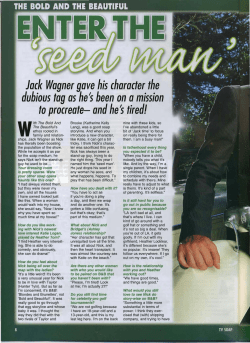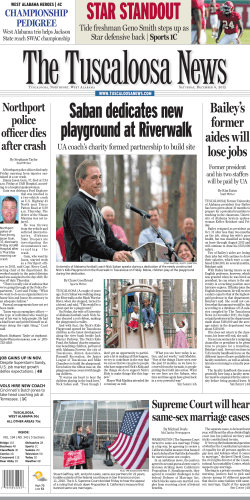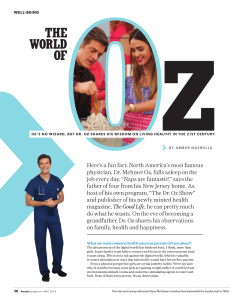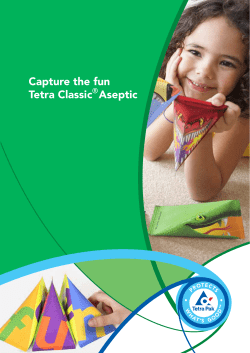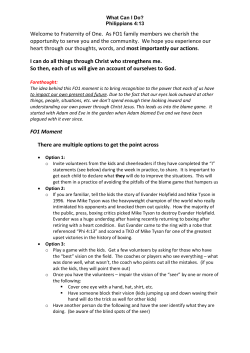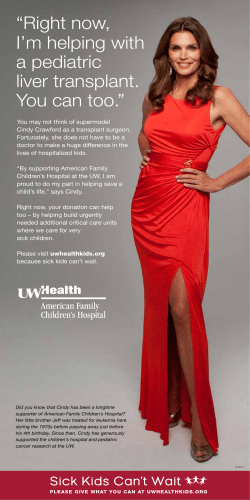
Document 59644
Research Final 1 Introduction The client that Two’s Company has chosen to pitch a campaign to is Nick’s Kids. Nick’s Kids Fund was originally started by Nick and Terry Saban while at Michigan State University, and has continued to support a variety of organizations. Today, the organization serves mostly the Tuscaloosa and Birmingham areas. The nonprofit does not raise money for one specific cause, but instead dedicates its efforts to supporting a wide range of organizations. The most notable contributions have been made toward the Habitat for Humanity, Birmingham Children’s hospital, student and family causes and tornado relief. In order to raise funds for these many causes, Nick’s Kids hosts several fundraising events ranging from a golf tournament to a fall auction. As a campaign group, Two’s Company would like to raise awareness toward this nonprofit since it is local and founded by Tuscaloosa’s most prominent figure, Nick Saban. Increasing awareness among students is the main focus, because it could result in volunteer opportunities. Increased volunteerism would be mutually beneficial to students and Nick’s Kids. Two’s Company believes that awareness about Nick’s Kids is not extremely high among the college student population. Therefore, Two’s Company is interested in assessing how many students are actually aware of Nick’s Kids. If they are aware of the organization, Two’s Company is interested in whether or not thoughts about the organization’s functions are skewed. For instance, a student may assume that funding for the organization comes directly from the Alabama football program and not from individual donors. By conducting a survey, Two’s Company will gather college students’ awareness about Nick’s Kids and by Research Final 2 the conclusion of the study possess an accurate idea about the awareness levels toward the nonprofit. Literature Review While Nick Saban is most famous for his dominance with the Crimson Tide, his career has moved him several times including Michigan, Florida, and Louisiana. Nick’s Kids was first started when Nick Saban was coaching in East Lansing, Michigan and he continued his charity efforts throughout each career move. Alongside Nick is his wife, Terry Saban, who has been extremely dedicated toward overseeing Nick’s Kids and the nonprofit’s growth. Since their move to Tuscaloosa, the couple’s prominence and charity efforts have raised more than 1.5 million dollars for Nick’s Kids. The couple uses their celebrity status to raise these large funds for their organization. For example, they host a celebrity golf tournament called Birdies for Charity. Luncheons, auctions, and private dinners are hosted at various venues throughout the year to encourage fund’s beneficiaries to continue supporting to Nick’s Kids. There are many resources that have information regarding Nick’s Kids. The organization’s official website offers much background information (Nick’s Kids). Nick’s Kids is a par of the Alma Foundation and a 501, non-‐profit charity (Sanckovich, 2012). In addition to this background information, the website also gives links to the organization’s Facebook and Twitter account. Both the Twitter (NicksKidsFund) and the Facebook pages (Nicks Kids Fund) seem well managed. They are kept up-‐to-‐date with events and media information that regards Nick’s Kids. Additionally, there are numerous news articles that have covered Nick’s Kids projects and events, especially those dealing with the tornado relief efforts. Saban used the Research Final 3 organization’s money to help both private and public relief efforts. A Tuscaloosa News article revealed that University of Alabama football coach Nick Saban and his wife Terry, donated $50,000 dollars from Nick’s Kids Funds to help a Holt family rebuild their home (Hurt, 2011). The Crimson White reveals that Nick Saban “gives anything he makes other than his normal salary – including more than $2 million in sponsorships – to Nick’s Kids” (Downing, 2011). After the April tornadoes, Nick’s Kids foundation did more than just donate money. According to an article on Scout.com they also helped with “feeding families at shelters, providing Wal-‐Mart gift cards to homeless families, and our members are volunteering for hands-‐on cleanup” (McNair, 2011). Other articles highlight events such as Nick Saban’s annual luncheon. An article from the Tuscaloosa News reveals that these types of events are targeted toward “a core group of 100 members who give annually to the fund were invited to the luncheon.” This article also states that quarterback AJ McCarron, running back Blake Sims, defensive lineman Quinton Dial, deep snapper Carson Tinker, cornerback Dee Milliner and center Barrett Jones -‐ signed autographs for those in attendance (Goodbread, 2013). Another major event for the organization besides the luncheon is a golf tournament. The golf tournament helps raise funds for the organization and according to an AL.com article, “a silent auction featuring a number of Alabama-‐related items” is also a part of the tournament (Hicks, 2013). Nick’s Kids also hosts events at professional sporting events via the Birmingham Barons. The baseball park hosts events before and after games to help raise money for Nick’s Kids. These special events “involve players throwing out the first pitch before each Research Final 4 night's game and a ‘Travelers Night at the Ballpark’ on Friday with five legendary players from the team taking part (Wray, 2013). In order to actually raise the money Milb.com promises that former members of the Crimson Tide Prince Wimbley, Derrick Owens Lassic, Antonio Langham, David Palmer and Tyrone Prothro each will through out a pitch prior to the game. For each strike thrown, Travelers will donate $500 to Nick's Kids Fund (2012). It is obvious that Nick’s Kids gets a lot of attention and coverage from the media, which is beneficial in gaining awareness and receiving donations. While Nick’s Kids receives meets its financial needs through donors, they also need volunteers to assist in running these events. Additionally, in order to complete the 15 for 15 project, many volunteers are needed to help build the 15 houses. For these needs the organization should reach out to college students. According to the Bureau of Labor Statistics, “volunteer rates among the 20-‐ to 24-‐year-‐olds is 18.9%” (Volunteering in the United States, 2012). Additionally, Cindy Kowal founder of Communities in Schools, states that “student volunteers form a significant percentage of volunteer bases” (Kowal, 2007). These statistics reveal that there are a significant amount of college students who are willing to dedicate their time to benefit volunteer organizations. Nick’s Kids should be presented this information to inform them that reaching out to college students would not be a waste of time. Research Questions Two’s Company believes that college students are not well informed about Nick’s Kids. Two’s Company assumes that a higher level of awareness among college students about the organization will produce more interest for Nick’s Kids. Consequently, the main research question that the survey hopes to answer is, will a higher number of informed Research Final 5 college students about the Nick’s Kids organization yield a higher level of interest in participation? Two’s Company also hopes to answer questions such as, do participants enjoy volunteering, do they enjoy working with children, would they rather donate their time or money, and what is their motivation behind their volunteer habits? Proposed Methodology In order to evaluate the awareness of Nick’s Kids among the college student population, Two’s Company is conducting a survey. In order to reach a significant amount of people in a limited amount of time, we believe this is the most appropriate and efficient method. Additionally, since many college students are preoccupied with internships, jobs and classes, finding a time for a focus group that works for everyone would be a difficult task. Two’s Company compiled a list of approximately twenty questions and formed a survey that will be posted online. Participants will be able to easily access the link via Facebook, Twitter or direct email. Since the survey only takes a minimal amount of time, we hope that this will minimize the dropout rate. The target demographic the survey will be targeted toward is college students and recent alumni ranging from ages 18-‐24. The survey will be administered at a large, southern university. There are no specific races, religions or socioeconomic statuses that Two’s Company intends to target. Additionally, both males and females will be surveyed. The survey utilizes different types of questions. The first question targets what kind of audience is actually participating in the survey (Appendix A). Since Three’s Company wants to find information about the college student population, hopefully most participants will fall under this category. Another type of question the survey uses is the open-‐ended Research Final 6 question. This question asks, “Why do you volunteer?” (Appendix A) People have a wide range of motivation that drives them to volunteer for a particular cause, which we did not think could be narrowed down to four or five specific causes. Throughout the survey Two’s Company also included many scale questions. The Likert scale questions have five points, ranging from “strongly disagree” to “strongly agree” (Appendix A). These scale items will help Three’s Company identify people’s enthusiasm towards volunteerism and their attitudes towards Nick’s Kids. These Likert scales can also help in analyzing data to make sure that participants in the survey were actually reading the questions and not just clicking random bubbles. In addition to Likert scale questions, the survey also includes semantic scale questions. This allows Two’s Company to determine participants’ feelings towards Nick Kid’s. The survey concludes with some basic demographic questions, such as, “Are you male or female?” (Appendix A). Targeted participants to take this survey are college students from a large southern university. The participants are gathered online. The survey is accessible through many online outlets including Facebook, Twitter and email. This type of information collection is beneficial to both Two’s Company and the participants. Participants do not have to take time out of their schedule to meet for a focus group. They are not asked to participate in any sort of experiment, so there are no potential legal implications that need to be explained. Additionally, the survey is short and should take no more than five to ten minutes to complete. The survey is extremely accessible and can even be opened up on a person’s smart phone, or iPad. Two’s Company believes that the accessibility and quickness will not irritate participants and encourage large participation numbers. Research Final 7 Another benefit to Three’s Company’s survey is anonymity. Participants are not watched while taking the survey, so this should allow them to feel comfortable with answering the questions honestly. In a focus group setting, a participant may feel uncomfortable admitting that he is completely oblivious to Nick’s Kids existence. However, in a survey, a person is much more likely to feel comfortable admitting his lack of knowledge towards the organization. The procedure that a participant goes through to participate in the survey is quite simple. After he receives the link, he/she simply clicks on the link. The link directs him/her to the survey. Before the survey actually opens, the participant is given an informed consent statement. The participant either agrees to the statement and continues to the survey or disagrees and is released from the survey. If the participant agrees to the terms of the survey, he/she will continue to the questionnaire. The first part of the questionnaire asks the participant about volunteerism. This includes whether he/she currently is involved in any volunteer opportunities, and his/her thoughts on volunteering as a whole. This includes whether he thinks volunteering is beneficial to others, and if so whether or not he/she enjoys volunteering with children. After the participant is asked various questions regarding volunteerism habits and attitudes, he is given a brief statement about Nick’s Kids. It is a brief quote that is part of the organization’s mission statement. Once a participant reads about Nick’s Kids mission, he/she is asked additional questions based off of the statement. Finally, after the participant has answered all the questions he/she is thanked for participating in the survey and is free to exit out of the link. Two’s Company hopes that the simple format of the survey will keep the dropout rate of participants at a low level. Research Final 8 Results In order to formulate a strong campaign for Nick’s Kids, 47 participants were surveyed. In the sample, 29.8% were male (n=14) and 70.2% were female (n=33). The mean age of participants was approximately 21 years old. A large majority (n= 38; 80.9%) of participants were current students at the University of Alabama, which is strongly associated with Nick’s Kids Foundation. Also, 14.9% (n = 7) of participants were alumni of the University, 2.1% (n = 1) described themselves as a fan/supporter, and 2% (n = 1) described themselves as “other.” Because of the small sample size in each group, statistic comparisons could not be run to explore differences in the university relationship variable. Several scales were compiled to better explore the concepts of volunteerism. All scales in this study maintained a Cronbach’s Alpha that is larger than .70. There were several important descriptive statistics revealed in this study. In terms of volunteering, 51.1% (n = 24)of participants revealed that they volunteer with a specific organization. The majority of the sample (n = 28; 82.4%) revealed that they volunteer with these organizations no more than four hours a month. This survey also sought to understand how aware the public is of Nick’s Kids foundation. A majority of the sample (56.8%, n = 21) had previously heard of Nick’s Kids. However, a majority of the sample (74.5%, n = 35) has no idea where the money that Nick’s Kids raises goes. Also, participants reported that they did not know any beneficiaries of Nick’s Kids (n = 34). When asked to approximate the amount of money Nick’s Kids donates each year, 1 participant estimated that it was less than $20,000; 11 participants estimated it was between $20,000-‐$100,000; 17 participants estimated it was between $101,000-‐ $500,000; and 17 reported that they did not have an estimation. Research Final 9 This survey also sought to understand the types of organizations participants believed benefitted from Nick’s Kids after learning about their mission. Approximately 90% (n = 44) of participants believed they helped out educational organizations, 67% (n = 33) believed they helped with tornado relief efforts, 47% (n = 23) believed they helped with women’s shelters, 84% (n = 41) believed they helped with special needs organizations, and 25% (n = 12) believed they helped the UA Athletic department. This survey also sought to understand the components that participants found most interesting about Nick’s Kids. The largest number of participants (n = 16) found the tornado relief efforts to be the most interesting component. That was closely followed by the connection between Nick’s Kids and UA Athletics (n = 15). Next, participants found the personal gratification one gets from volunteering interesting (n = 12). The component of Nick’s kids that the fewest number of participants found most interesting was the service hours that can be logged by participants (n = 2). The “donation vs. time” scale accumulated a mean score of 2.47. This suggests that people see the value in spending their time volunteering rather than simply donating their money to charity. An independent samples t-‐test revealed that men scored significantly higher (M = 3.23) than women (M = 2.15) on the donation vs. time scale t(45) = 4.28, p < .001). The children’s organization scale accumulated a mean score of 3.67 among all participants. This suggests that people generally see volunteering with children’s organizations as an opportunity that interests them. An independent samples t-‐test revealed that women scored significantly higher (M = 3.96) than men (M = 3.00) on the children’s organization scale t(45) = -‐3.15, p < .05). Research Final 10 The volunteerism scale accumulated a mean score of 4.04 among all participants, suggesting that participants enjoy volunteering. An independent samples t-‐test revealed that women scored significantly higher (M = 4.48) than men (M = 3.07) on the volunteerism scale t(45) = -‐5.3, p < .05). The “working with children scale” accumulated a mean score of 3.72 among all participants. This suggests that participants do enjoy working with children. An independent samples t-‐test revealed that women scored significantly higher (M = 3.95) than men (M = 3.17) on the working with children scale t(45) = -‐2.49, p < .05). The “personal connection scale” accumulated a mean score of 3.88 among all participants, suggesting that people enjoy charitable organizations that helps people that they know personally. An independent samples t-‐test revealed that women scored significantly higher (M = 4.03) than men (M = 3.54) on the personal connection scale t(45) = -‐2.07, p < .05). The knowledge scale accumulated a mean score of 2.18 among all participants. This suggests that people do not know much about Nick’s Kids Foundation. An independent samples t-‐test revealed that there were no gender differences in terms of the knowledge participants had about Nick’s Kids Foundation, t(45) = -‐0.34, p > .05). The “Nick’s Kids volunteer interest scale” accumulated a mean score of 3.74 among all participants. This suggests that people would be interesting in volunteering once they learned more about the organization. An independent samples t-‐test revealed that women scored significantly higher (M = 3.92) than men (M = 3.31) on the Nick’s Kids volunteer interest scale t(45) = -‐2.33, p < .05). Discussion Research Final 11 The results yielded from the survey provide Two’s Company with a variety of interesting and significant data. The survey successfully reached the demographic that Two’s Company wanted to measure. Two’s Company wanted survey 18-‐24 year olds, including currents students and young alumni. The average age of the participant was approximately 21 years old, which is right within the target audience. Additionally, over 80% of the participants were current students, making Two’s Company’s results applicable to the level of awareness of Nick’s Kids among college students. In addition to demographic information, the study uncovered participants’ general volunteer habits. Over half of the participants claimed that they volunteer with some sort of organization. Out of those who volunteer, 82% said that while they volunteer, they do not dedicate more than four hours a month. College students are bombarded with various responsibilities and activities, it is not surprising that they dedicate somewhat low hours to volunteer organizations. However, this survey was administered in the summer time and students have more time on their hands than they may have during the actual school year. The results may have been even smaller if the survey had been administered during another time of the year. Another portion of beneficial information that was gained from survey responses was participants’’ initial awareness of Nick’s Kids. Two’s Company previously assumed that a low number of college students had never heard of Nick’s Kids. However, almost 57% of the sample was aware that Nick’s Kids exists. While there was awareness of the organization, an overwhelming amount of participants stated that they are unsure of where the money raised from Nick’s Kids is distributed. Research Final 12 After learning a little more about what Nick’s Kids does through a debriefing statement in the middle of the survey, participants gained a better understanding of the types of organizations that Nick’s Kids donates to. The study revealed the area that most interested participants was Nicks Kid’s tornado relief efforts. This is extremely relevant information in regards to the demographic audience. Because the students’ average age is 21 years old, many of them experienced the devastation of the April 2011 tornado firsthand. A specific scale administered in the survey was the “personal communication scale”. This scale revealed that people are more apt to volunteer for an organization that helps people that they have a connection to or that helps someone that they know. Many students’ who experienced the tornado, know someone who was directly affected by the tornado. There are many differences between men and women that the survey revealed. As a whole, college students are more likely to donate their time than money. This is understandable because college students do not have disposable income. However, when broken down into male versus female, men would rather simply donate money, while women stated that they prefer to volunteer their time to an organization. Similarly, as a whole the sample said they prefer volunteering for children’s organizations. However, women scored much higher on this scale when broken down through t-‐tests. Additionally, overall the sample expressed that they enjoy volunteering. But yet again, women’s level of enjoyment was higher than males. Finally, the “Nick’s Kids volunteer interest scale” followed in the same pattern, suggesting people were interested in volunteering for Nick’s Kids once they knew more about the organization. However, women expressed a higher interest in volunteer interest for Nick’s Kids. It seems as though women scored much Research Final 13 higher in many aspects of the survey than males. However, Two’s Company must keep in mind that nearly 70% of the sample was female, while only 30% of participants were males. This unbalance of males and females could have somewhat skewed these results and comparisons. It may be beneficial for Two’s Company to attempt at a more balanced sample size in regards to male and female participants. Two’s Company can utilize this gained knowledge to form a successful campaign for Nick’s Kids. The target audience that Nick’s Kids should specifically go after are potential female volunteers. Because women expressed higher levels of interest in many aspects of volunteering, including volunteering for Nick’s Kids, they should be the primary focus. Where is the easiest place to find large numbers of females in one place? University of Alabama sorority houses. According to The Crimson White, “the Greek community at UA is the largest in the United States as far as number of members, and Greek life at UA has more than doubled since 2002.” (Thurbur, 2012). Part of sorority involvement is volunteering a specific amount of time towards volunteer efforts. University of Alabama sorority members have already shown large amounts of interest in tornado relief efforts. According to the Tuscaloosa News, following the April 2011 tornado, the Greek community came together and formed “a student-‐led initiative that has distributed more than 52,000 meals to victims and volunteers after the devastating tornadoes of April 27, has launched a fundraising campaign that is continuing during the football season” (Gray, 2011). This supports the results from the “personal connection scale” in Two’s Company survey and reveals that the target group should be active sorority members who already possess regular volunteer habits. Research Final 14 Because sorority members have already taken initiatives toward tornado relief efforts, Nick’s Kids should focus on marketing its 15 for 15 Habitat for Humanity project. Sorority members have the personal connection towards the project and need to reach specific amounts of service hours. According to Alpha Delta Pi president, Katie Saunders, a member must complete a total of 10 volunteer hours per semester in order to remain in good standing in the sorority (personal communication, July 28, 2013). Because many participants in the survey expressed that they find it interesting that there is a connection between Nick’s Kids and the UA athletic community, Nick’s Kids should utilize these connections. Nick’s Kids could integrate football players in the 15 for 15 Habitat for Humanity for project. By having football players help support an event that helps tornado relief, this meets the participants’ criteria of personal connection and interest in UA athletics. Nick’s Kids has not been fully taking advantage of the many volunteers that could potentially assist their organization in reaching and helping more people. By increasing awareness among college students, it is Two Company’s belief that they will receive much higher levels of interest towards their organization volunteer efforts, specifically from the female sorority members. Research Final 15 References College of Arts and Sciences. (1, December 2012). Nick’s Kids Fund Continues Commitment to Brewer-‐Porch Children’s Center. Downing, Jared. (7, November 2011). Saban teams up with Habitat for Humanity to create Nick’s Kids. The Crimson White. Print. Goodbread, Chase. (2, August 2012). Nick’s Kids Fund distributes 415K at annual luncheon. Retrieved on July 20, 2013, from http://www.tuscaloosanews.com/article/2 0120802/NEWS/120809964 (Gray, Jake). (24 October, 2011). UA Greeks raise funds for tornado relief. Tuscaloosa News. Retrieved from http://www.tuscaloosanews.com/article/2011 1024/NEWS /111029886 Hicks, Tommy. (6, June 2013). Saban: Golf not focal point of Nick’s Kids Fund golf tournament. Retrieved on July 20, 2013, from http://www.al.com/sports/index.ssf/2013/06/saban_golf_not_focal_point_of.html Hurt, Cecil. (21, May 2011). Saban’s Nick’s Kids foundation working to help tornado victims. Retrieved on July 20, 2013 from http://www.tuscaloosanews.com /article/20110521/NEWS/110529981 Research Final 16 Kowal, Cindy. (2006-‐2007). Using College Students as Mentors and Tutors. Retrieved from http://www.communitiesinschools.org/media/uploads/attachments/Cindy_Kowal_ Fellows_Report.pdf McNair, Kirk. (4, May 2011). Nick’s Kids Helping Tornado Victims. Retreieved on July 20, 2013, from http://alabama.scout.com/2/1069692.html. Nick’s Kids Fund. (n.d.) Retrieved on July 20, 2013, from http://www.nickskidsfund.com Nick’s Kids Fund. (n.d.). In Facebook [Fan page]. Retrieved on July 20, 2013, from http://www.facebook.com/NicksKidsFund Nick’sKidsFund (25, July 2013). Nick’s Kids in the news! [Twitter Post]. Retrieved on July 20, 2013, from http://twitter.com/NicksKidsFund Sankovich, Sam. (3, April, 2012). Nick Saban: Nick’s Kids Fund. Retrieved on July 20, 2013 from http://thegoodinsports.com/2012/04/03/nick-‐saban-‐nicks-‐kids-‐fund/ Thurbur, Katie. (1 August, 2012). Sorority rush numbers at record high. The Crimson White. Retrieved from http://cw.ua.edu/2012/08/01/sorority-‐rush-‐numbers-‐at-‐record-‐ high/ Traveler’s and Baron Team Up for Nick’s Kids Fund. (23, August 2012). Retrieved on July 20, 2013 from http://www.milb.com/news/article.jsp?ymd=20120823&co ntent_id=37224454&vkey=news_t247&fext=.jsp&sid=t247 Volunteering in the United States. (22, February 2012). Bureau of Labor Statistics. Retrieved from http://www.bls.gov/news.release/volun.nr0.htm Wray, Cheryl. (24, July 2013) ’92 Alabama national championship team members to appear at Birmingham Barons games this week. Research Final 17
© Copyright 2026
